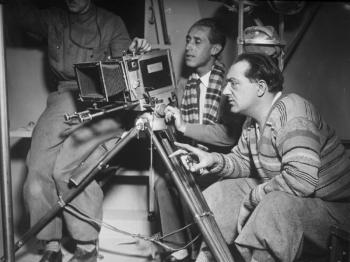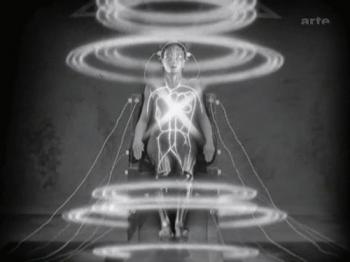Fritz Lang’s Metropolis
I’m trying to remember a sci-fi movie without a robot or something robotic in it. The Teminator? No. Avatar? No, there were exoskeletons. Star Wars? No, C-3P0 and R2-D2 among other robots. Predator? Well, yes, but if we look at the expanded universe then there were robots in the Aliens. A.I. Artificial Intelligence? Duh, it was all about robots!
I’m sure there are some iconic sci-fi movies without a trace of robotics. However, you have to admit these movies are a minority. But have you ever wondered which actually is the first movie that features a robot? If you read my site you probably know that R.U.R by Karel Capek was the first play with robots. But it has to be yet adapted into a movie. I’ve heard rumors that we can expect a movie based on that play in 2011
.
The first movie that features a robot is 1927 silent film Metropolis directed by Fritz Lang and written by Thea von Harbou and Fritz Lang. Before I dive into the movie, it’s plot and the robot, I’d like to tell you about the director himself, his life and the impact on film-making he created.
Fritz Lang

As his name suggests, Fritz Lang is an Austrian born filmmaker. Born in Vienna, Austria-Hungary in 1890, he spent his youth studying different disciplines such as engineering, arts and painting as well as travelling around the world – Europe, Africa and Asia. When the WWI came along he volunteered and fought for Austria. While injured he wrote a few film scenarios.
Later he mostly switched writing for directing and started making movies. He created art films, as well as popular thrillers and created interesting synthesis of art cinema and popular genres. His works from pre-WWII period are often cited as important examples of German expressionism.
In 1920 he met his future wife – Thea Von Harbou together with whom he wrote the script for Metropolis among other movies. Things got complicated when the Nazi started their struggle for power. Although Fritz Lang didn’t sympathize with them partly because his mother was Jewish and although he wasn’t raised as such, under Nazi laws he’d qualify as Jewish and could be persecuted, his wife Thea joined the NSDAP in 1932.
Although it’s hard to verify from other sources, Fritz Lang maintained that Goebbels (the Nazi propaganda minister) offered him a position as the head of German film studio UFA because of his exceptional film making skills despite the fact that the Nazis banned his movie The Testament of Dr Mabuse as anti-Nazi. In either case, Fritz fled the Nazi Germany in 1934 for Paris thus ending his marriage with Thea Von Harbou.
In 1936 Lang moved to the USA and joined the MGM film studio. During his active american career from 1936 to 1957 he created twenty one feature films under every major studio in Hollywood and as an independent director. His films were often under evaluated by contemporary critics who compared them with his earlier works. Although his career ended unnoticeable, later it was acknowledged that his work played an important role in the birth of film noir genre.
Metropolis

This is nice but what about robots, you ask? As I mentioned earlier Fritz Lang’s Metropolis is the first movie that features a robot. As if that wasn’t enough – it is the most expensive silent movie ever made. It also has a very important place in the beginnings of science fiction genre. Apart from this there’s another interesting twist in this story. Read on!
Oh, almost forgot! Although the movie isn’t the latest and greatest blockbuster that everyone is crazy about, I still have to warn you – SPOILERS ahead. So, in case you want to see it with an opinion clear mindset you should do it before reading further. If you’re going to watch it now search the 2010 restored version. Why? I’ll explain a bit later.
Although you can stumble on a few slightly different plot versions the main story line of the movie goes like this. Sometime in future there’s a great city – a metropolis. People in this city are divided into two subgroups – the workers and the thinkers. Or, as sometimes referred – the muscle and the brain. The workers work long hours doing dull, hard, boring and mechanical in nature jobs while the thinkers do office jobs and their sons lead lives full of luxury.
The city is divided too – the workers’ city is located deep below surface, while the thinkers live in towers high above ground. One day the son of the city ruler finds out the hardships workers have to endure and gets pretty upset about the fact. He later finds out that a woman named Maria secretly preaches to the workers who are on a verge of revolt. Her main teaching is that there should be a mediator between the workers and the thinkers.
The Metropolis’ ruler Joh Fredersen together with an old scientist named Rotwang secretly visits one of these sermons. Fredersen finds Maria’s power over workers troublesome so he instructs Rotwang to give Maria’s looks to the machine-man that Rotwang had shown him earlier. Rotwang, however, bears a grudge against Joh Fredersen because of a woman they both loved. So he instructs the robot to destroy Metropolis, Fredersen and his son.
Now you approximately know where the robot fits in this movie. If you want to know what happens next – watch the movie! No, really, it’s worth it, as you can understand this summary is as short as it can get and the movie explores different topics – religion, love, work, social equality and more. I think everyone can perceive it a bit differently depending on the particular point of view and experience.
What I want to discuss more are ideas about robotics and technological advancement conveyed by Metropolis. First of all, when watching the movie you have to bear in mind that it was made before the advent of computers, automation, etc. So, it’s quite obvious why there’s this assumption that modern society could only work with a large mass of workers behind that do dull and tedious jobs.
As in this movie human workers do those triple-D jobs this is not the “usual” case where robots revolt against humans. In Fritz Lang’s Metropolis a robot is disguised as a human leader in order to carry out revenge. Also, the reason why the machine-man was created in the first place is quite interesting too.
There are two main reasons why robots are created, both in science fiction and the real world. Either robots are created to work for us as in Karel Capek’s R.U.R., or to create life. It’s the second case with Fritz Lang’s Metropolis. Actually, it’s more than that. The old scientist Rotwang creates the robot in hopes to recreate a woman he once loved and lost to Joh Fredersen and who died giving birth to Fredersen’s son.
This is the reason why he orders the robot to initiate mayhem that would eventually destroy Fredersen, his son and Metropolis. So I guess it can be said that malicious use of technology is one of the issues explored in Fritz Lang’s Metropolis.
Different versions of Fritz Lang’s Metropolis and which one should you watch
I hope I managed to rouse interest and you’re willing to watch it yourself. If so, you have to know that there’s a few different versions you can stumble upon. In an interview with novelist Robert Bloch when asked about Metropolis, Fritz Lang replied, “Why are you so interested in a picture that no longer exists”. Let me explain a bit more.
Metropolis saw its premiere in 1927 in Berlin. It was a 153 minute long feature film. However, after its release few people outside Germany saw it as intended by Fritz Lang. The reasons for this are quite trivial – theaters were reluctant to play a movie longer than 90 minutes. So it was cut heavily and demonstrated at a faster rate.
Moreover, in the United States Fritz Lang’s Metropolis’ original plot was viewed as too controversial and a different version edited by Channing Pollock was shown. Thus you can find versions where the robot is created in order to replace the worker class and where it’s not really clear why the robot became malevolent.
Don’t get too upset though. Although a quarter of the film was considered lost forever, we’re quite lucky to happen to live know. In 2008 a negative of the original movie was found in a museum in Argentina. Although it was in poor condition, Fritz Lang’s Metropolis saw its rebirth in 2010 in theaters around the world as well as on DVD.
Although this restored version also misses a few frames it’s very good when compared to other versions which miss considerable amount of footage and in worst cases even have a significantly different story line. So if you want to see it you can get a DVD somewhere, or if you’re OK with watching on your computer and switching between parts you can search Youtube for “Metropolis restored version 2010 (1080p)”. This is the best version on Youtube I managed to find!
Go back to “Robotics history” from “Fritz Lang’s Metropolis”.
